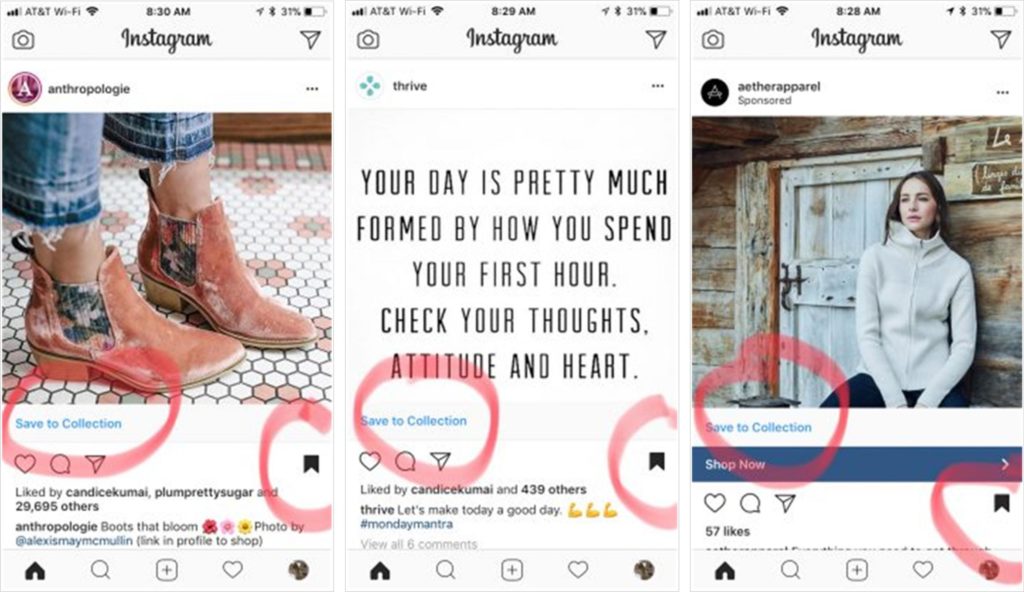Instagram seems to roll out a new feature daily. This is exciting, and there’s so much we can do with Instagram’s ever-evolving features like Instagram Stories. But these rapid-fire feature roll-outs also mean that we marketers are often experimenting without access to all the data, i.e., the full view of how Instagram activities and campaigns are performing.
And, once you do have access to all the relevant Instagram data, what do you do with it? Which metrics actually help you gauge success, and which metrics are just more “information noise” you find it difficult to act on?
We’re here to help. These are the five Instagram metrics you should be tracking, especially if you’re using Instagram Stories or considering doing so.
#1 – Instagram Saves
When an Instagram user saves your Instagram content—a photo, video, carousel, or even a sponsored post—he or she is saying, “I care about this. I don’t want to lose this content/information, and I want to return to it later.”
An Instagram user’s Saves live on their account profile under the Save icon, where the user can return to the content whenever he or she chooses. A user’s Saves are private—only he or she can view these pieces of content.
Knowing which brand content gets saved most gives you an additional layer of social performance data. Some angles/hypotheses to consider (and test by looking at your brand’s data):
- Saves are a high indicator of intent to buy. High-Save pieces of content featuring product will correlate to higher direct traffic to your website and/or specific product page.
- Saves are a high indicator of quality content. High engagement as a general metric indicates that your post was effective enough to make followers pause in their feeds and pay attention. But Save data takes this journey one step further. Your audience members didn’t just tap the Like icon or tag a friend; they put that content in their back pockets to revisit later. Over time, viewing this data can give you some very clear guidance on which Instagram content resonates (and converts) with your audience.
- Saves are a high indicator of “heart-hitting” content.Instagram users save posts that are meaningful to them, like places they want to visit, places they’ve been and loved, inspirational quotes, or people they admire. Experiment with creating more content like this and see if/how your Instagram Save data changes over time.
#2 – Instagram Stories Views
If you’re using/experimenting with/dipping your toes into Instagram Stories, we recommend dedicating a stronger effort to this platform feature. It’s no longer emerging—it’s here to stay, and it’s a great way to introduce flexibility, spread awareness about events and product launches, encourage audience interactivity, keep your brand top-of-mind (and top-of-feed), and even drive conversions to your site.
Build a strategy around Instagram Stories, and include your Instagram Stories view data in your total engagement numbers when you’re running analysis and reporting up.
#3 – Instagram Engagement Rate
The best way to calculate Instagram engagement rate is total engagement (views and post engagement) divided by total impressions (number of times posts were seen). This will give you an accurate depiction of how many times per view you received interactions on your content.
By tracking this rate over time, you’ll be able to make engagement-driving improvements to your content, using this number as a North Star.
Related Post: How to Set Up Google Analytics on Your Site
#4 – Instagram Stories Exits
So you’re investing in Instagram Stories, and you know your Stories are being watched—but do you know how frequently they’re being exited? What does that ratio (views to exits) look like for your brand? How can you improve the ratio? A high number of exits means:
- Your Instagram Stories are boring
- Your Instagram Stories promise something they don’t deliver
- Your Instagram Stories don’t align well with your brand
- You’ve chosen the wrong influencer(s) or brand(s) to partner with
- You haven’t dialed in your visuals yet
- You haven’t found a way to frame your product in a way that resonates for Instagram Stories
A high number of exits might also mean that you don’t have a strong enough understanding of what your target audience wants to see on Instagram.
#5 – Instagram Stories Tap-Backs + Tap-Forwards
Maybe exits aren’t your problem. Maybe your followers are interested in some Instagram Stories you put up, but bored by other Instagram Stories you put up.
Don’t you want to know which content your followers love so much they want to watch it again (Tap-Back), and which content makes followers roll their eyes, ready to move on to the next thing (Tap-Forward)?
This information will help you create more effective content in the future, and, especially in your longer Stories, hone in on exactly what is driving rewatches and exactly what is causing fast-forwards.






